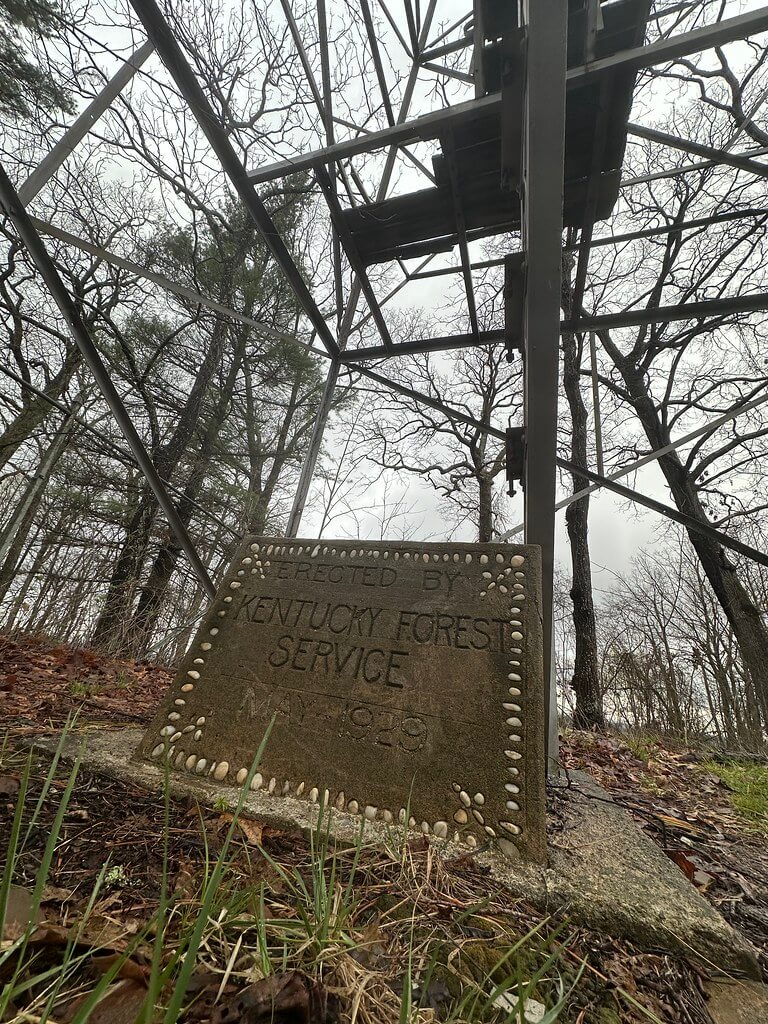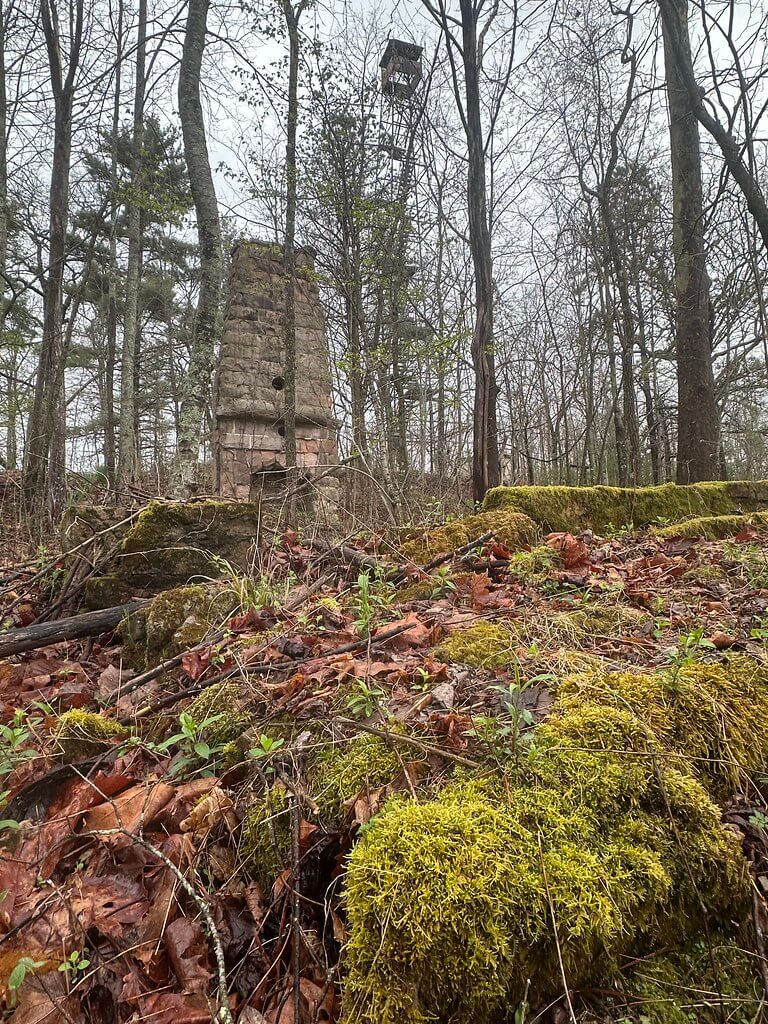Abandoned Appalachia Series – The Beschman (Putney) Lookout Tower of Harlan County

High on Pine Mountain’s crest in eastern Kentucky, a rusted steel skeleton stands watch over the ridges: the Beschman Lookout Tower, better known by its local name — the Putney Fire Tower. Time and thick forest growth have largely hidden it from passing eyes, but once upon a mid-20th-century day, it guarded Harlan County’s woodlands with unwavering vigilance. Today, it’s just another crumbling relic, one with a storied past stitched into the mountainous tapestry of coal towns, Civilian Conservation Corps (CCC) projects, and old ghosts that still wander these hills.
A Depression-Era Guardian
Like many public works scattered across Appalachia, the Beschman Tower rose from the synergy between Kentucky’s Division of Forestry and the New Deal’s CCC in the late 1930s. Perched at roughly 2,726 feet atop Pine Mountain, its strategic vantage point delivered 360-degree views of the densely timbered valleys below. This spot was (and still is) part of Kentenia State Forest — Kentucky’s oldest state forest, itself donated to the Commonwealth in 1919. At the time, forest fires were a constant menace. Resources were scarce, and each spark risked destroying not only the timberlands but the countless coal camps tucked into the hollows.
The CCC carved an access road — Gross Knob Tower Road — to haul equipment and string a rudimentary telephone line from the mountaintop down to the Putney Ranger Station, a sturdy log cabin built at the foot of the mountain. They erected the tower in 1929 mentioned by the stone at the base of the tower. It is believed the tower became operational around 1937–1938, it was staffed daily during the dry seasons. A lone fire lookout would climb the long flights of stairs, scanning the horizon for any wisp of smoke. Once spotted, a quick phone call sent local rangers racing into action. In those days before airplanes and helicopters were routinely used in firefighting, a sharp-eyed observer in a mountaintop tower could mean the difference between a minor brush fire and a devastating inferno.

Rise and Fall
Throughout the 1940s and ’50s, Beschman Tower and its companion ranger station served as Harlan County’s firefighting nerve center. Locals talked of rangers living at the cabin below, bounding up the mountain at dawn, and keeping watch from that precarious steel vantage point. By the 1970s, though, planes and modern communications began to replace the old manual methods. State budget cuts and shifts in policy led to the tower’s official decommissioning around this time. Ownership never changed — it remained state property in Kentenia State Forest — but maintenance ground to a halt. The lower stair flights were purposely removed to discourage trespassing (and liability), and the tower was effectively left to the elements.
In the decades that followed, the place devolved into a playground for adventurous hikers and local teenagers looking for a thrill. Stories floated around of daring climbs and shaky boards, of people climbing halfway up the tower at night, hearts pounding as the wind howled through the open lattice. Rust consumed the metal rails, wooden landings rotted or fell away, and the once-proud observation cab was stripped bare by time. Yet still it stood, the steel frame refusing to yield to the mountain’s slow, persistent reclamation.
Echoes of Lore and Legend
It’s impossible to speak of Pine Mountain without touching on the region’s deep folklore. Harlan County is a place where ghost stories, murder ballads, and local heroes mingle as part of daily life. The Putney Ranger Station at the foot of the mountain is said to be haunted by the spirits of long-deceased rangers — some claim they still “keep watch” in the afterlife. Folks whisper about footsteps in empty hallways and doors that open themselves. Given how closely tied the tower was to the station’s history, it’s no stretch to imagine a solitary ghost climbing those rusted steps, scanning the horizon for smoke on a mist-shrouded dawn.
Not far from the tower’s location lie other grim echoes: the unsolved murder of a “Mountain Jane Doe” discovered along Little Shepherd Trail in 1969, or the earlier tragedy of schoolteacher Lura Parsons, who was brutally slain on Sept 7, 1920 on the opposite side of Pine Mountain. These stories cast a melancholic shadow across the ridgeline — time-capsule reminders that life in these mountains has never been simple or gentle.

The Tower Today
If you stumble upon Beschman Tower now, be prepared for a scene of raw Appalachian decay. A tangle of brush, briars, and trees partially obscures the base, and the bottommost steps are conspicuously missing. A small concrete-block shed still hugs one leg — once a storage spot for telephone equipment. The steel lattice, battered by decades of storms, remains upright but pitted with rust. Some intrepid souls have nailed makeshift boards into place for a short climb, but beyond that, the structure is dangerously unstable. Most local guides strongly advise against climbing it. “Enter at your own risk” might as well be stenciled across the tower’s battered steel.
Legally, the tower still belongs to the Commonwealth of Kentucky. It’s tucked away on a chunk of public land that sees scant official oversight these days. On rare occasions, some local historical or heritage group floats the idea of restoring it — similar to recent (and still ongoing) efforts to rehabilitate the old ranger station. But so far, no rescue plan for the tower has materialized. Until that changes, Beschman Tower is left to stand or fall on Pine Mountain, awaiting either a slow collapse or a new breath of life from preservationists.
Getting There
For the curious, the route generally starts along KY 1679 — Little Shepherd Trail — a scenic but narrow mountain road. People often park near Goss Park or along a small pull-off, then hike or scramble the remnants of the old CCC road to the tower site. The trek is short but steep, with no official signage pointing the way. A GPS reading near 36.9269° N, 83.2243° W helps locate what’s left of the structure. Be mindful: it’s an unmaintained area, and if you get into trouble, help is a long time coming. Cell service is spotty on these wooded slopes.

Reflections on a Tower’s Legacy
In the 1930s, as the Great Depression gnawed at the nation, the CCC and other New Deal programs built tangible hopes in places like Harlan County — hopes forged in steel, sweat, and a communal resolve to protect the land and its people. Beschman (Putney) Lookout Tower epitomizes that era: a practical piece of firefighting infrastructure and a testament to human perseverance in rugged Appalachia.
When you stand beneath those towering girders, it’s hard not to imagine an earlier time — rangers perched at the top, scanning endlessly for swirling plumes of smoke. They were guardians of these forests, watching out for the next threat while the radio crackled and the wind battered the metal cab. Down in the valley, families rested easier knowing that someone was on duty, day in and day out.
Decades later, that sense of watchful vigilance lingers like an echo. Though no one stands there now, the tower itself stands witness to the passage of time — through each season’s storms, blazing summers, and ice-laden winters. Perhaps, in a twist of fate, the tower has become a symbol of the region’s own resilience. It’s a silent sentinel that has outlived its intended purpose but still speaks volumes about the people who built it and the ghosts (both literal and figurative) that haunt these ancient mountains.
For now, Beschman Tower’s future remains uncertain. Maybe it will one day be restored — reborn as a scenic viewpoint for hikers or a living museum to the CCC’s legacy. Or maybe it will succumb to the unstoppable march of decay, collapsing in a silent crash heard only by the wind and the wildlife. Either way, this lonely spire atop Pine Mountain endures, a rusted relic telling stories of a Kentucky that once was — and, in some ways, still is.
Sources & Further Reading
Harlan Enterprise — Articles on Putney Ranger Station restoration efforts and local memories (2019)
Kentucky Hiker Project — Exploration logs and photographs of the tower’s current condition
Kentucky Heritage Council — Historic context on New Deal construction and CCC projects in eastern Kentucky
Harlan County Trails Tourism — Local ghost lore, unsolved murders, and haunted sites around Pine Mountain
AbandonedOnline.net — General history of fire lookout towers and the CCC’s nationwide infrastructure work
TopoZone — Mapping data for Pine Mountain’s crest and the tower’s elevation coordinates
(Note: All references are cited in condensed form for readability; see original documentation and agency records for in-depth coverage.)
Author’s Note: This piece is part of the Abandoned Appalachia series, an ongoing exploration of once-thriving communities across the region — places where generations found work, camaraderie, and identity, only to see it all fade as energy markets plummeted, times shifted, and mines went dark. Follow along for more stories of resilience, reinvention, and the powerful lessons these hills still hold.